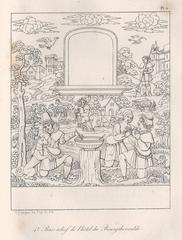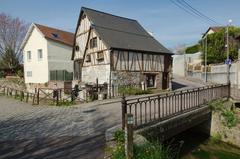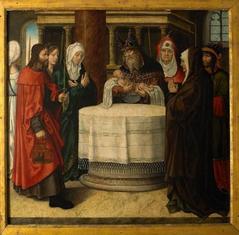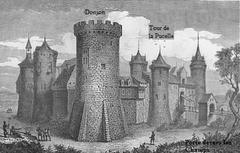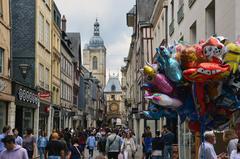
Rouen Ceramic Museum: Visiting Hours, Tickets, and In-Depth Guide to Rouen’s Ceramic Heritage
Date: 04/07/2025
Introduction
Nestled in the historical core of Rouen, France, the Rouen Ceramic Museum (Musée de la Céramique de Rouen) is a premier destination for art lovers, history enthusiasts, and travelers eager to explore Normandy’s cultural treasures. This comprehensive guide covers everything you need to know about the museum: its rich historical significance, visiting hours, ticketing, accessibility, must-see highlights, and practical tips for planning your visit. Discover how the museum’s collections and setting in the 17th-century Hôtel d’Hocqueville offer a unique window into centuries of ceramic mastery and the enduring legacy of Rouen as a center of French faience (Musée de la Céramique de Rouen - Wikipedia, Visiter Rouen, Which Museum).
Table of Contents
- Overview and Historical Context
- The Hôtel d’Hocqueville: Architectural Gem
- Rouen Faience: Evolution and Artistic Significance
- Collections and Exhibition Highlights
- Museum Mission: Preservation, Education, and Research
- Visiting Information: Hours, Tickets, and Accessibility
- Visitor Experience and Practical Tips
- Integrating the Museum into a Rouen Itinerary
- Visuals and Digital Resources
- Frequently Asked Questions (FAQs)
- Conclusion and Final Recommendations
- References and Further Reading
Overview and Historical Context
Founded in 1864, the Rouen Ceramic Museum preserves the legacy of Rouen’s faience and ceramic artistry—a tradition rooted in the Renaissance and elevated through the innovations of Masséot Abaquesne and Edmond Poterat. Rouen’s status as a ceramics powerhouse was established in the 16th century, with Abaquesne’s remarkable pharmacy jars and decorative pavements setting the standard for French Renaissance ceramics. The city’s faience industry experienced a significant revival in the 17th century, particularly after a royal monopoly was granted to Edmond Poterat in 1644, resulting in the iconic “blue mantling” (camaïeu bleu) wares that became synonymous with Rouen’s style (Visiter Rouen).
Despite changes and competition in the 18th and 19th centuries, Rouen’s impact on French and European ceramics remained profound, with the museum today holding over 5,000 pieces that trace the evolution of local and continental ceramic traditions.
The Hôtel d’Hocqueville: Architectural Gem
The museum is housed in the Hôtel d’Hocqueville, a beautifully preserved 17th- and 18th-century private mansion. The building itself is an essential part of the visit, standing atop the remains of Rouen’s medieval castle and the ancient Gallo-Roman amphitheater of Rotomagus. Its elegant Norman facades, ornate stonework, period rooms, and terraced gardens provide a fitting backdrop for the museum’s collection and vividly illustrate the domestic and ceremonial uses of Rouen ceramics (Musée de la Céramique de Rouen - Wikipedia).
Rouen Faience: Evolution and Artistic Significance
Rouen faience is celebrated for its technical excellence and distinctive decorative language. The museum’s collection showcases:
- Renaissance Paving by Masséot Abaquesne: Early examples of French faience, including pharmacy jars and decorative tiles.
- Camaïeu Bleu: The hallmark blue-and-white ware of the 17th and 18th centuries, inspired by Chinese porcelain and local innovations.
- Polychrome Rocaille and Chinoiserie: 18th-century wares with playful, exotic motifs and Rococo exuberance.
- Grand Table Services and Sculptures: Monumental pieces crafted for aristocratic patrons.
- Comparative Collections: Faience from other French centers such as Nevers, Moustiers, and Marseille, and international ceramics from Italy, the Netherlands, and England (Rouen Official Site).
Collections and Exhibition Highlights
Permanent Collections
- Rouen Faience: Tin-glazed earthenware central to the city’s artistic identity. Highlights include albarelli (apothecary jars), plates, ewers, and monumental fountains like the “Fontaine aux Dauphins.”
- French and European Ceramics: Works from Sèvres, Nevers, and other renowned centers, alongside imported pieces for comparative study.
- Architectural Ceramics: Tiles, stove fronts, and decorative panels illustrating ceramics in both domestic and public spaces.
- Notable Masterpieces:
- Masséot Abaquesne’s Renaissance tiles and pharmacy jars
- Chinoiserie and grotesque motifs on 18th-century tableware
- Sculptural works by Pierre II Chapelle
Thematic and Interactive Exhibits
- Decorative Arts and Daily Life: Reconstructed historic table settings and period interiors.
- Artistic Techniques: Interactive panels and recreated workshops demonstrate glazing, painting, and firing processes.
- Temporary Exhibitions: Regularly changing shows highlight contemporary ceramics, cross-cultural influences, and collaborations with other museums.
Museum Mission: Preservation, Education, and Research
- Preservation & Conservation: The museum employs advanced techniques to restore and safeguard ceramics, integrating archaeological finds from the region.
- Education & Public Engagement: Through workshops, lectures, guided tours, and family programs, the museum fosters appreciation for ceramic art and welcomes all ages.
- Research & Scholarship: It serves as a hub for ceramic research, with archives, scholarly publications, and partnerships with universities and cultural institutions.
- Cultural Promotion: The museum participates in major cultural events and supports community initiatives, reinforcing Rouen’s standing as a UNESCO Creative City (Rouen Cultural Heritage).
Visiting Information: Hours, Tickets, and Accessibility
Location
1 Rue du Faucon, 76000 Rouen – centrally located near Rouen’s historic quarter and major attractions.
Visiting Hours
- Standard: Open Tuesday to Sunday, typically from 10:00 AM to 6:00 PM (some sources cite 2:00 PM to 6:00 PM; verify on the official website for current hours).
- Closed: Mondays and certain public holidays.
Tickets
- Permanent Collections: Free admission.
- Temporary Exhibitions/Special Events: Tickets may be required; see the museum’s website or visitor portals for details.
- Rouen Museum Pass: May include access to several city museums (Which Museum).
Accessibility
- The historic building offers partial accessibility. Some areas may pose challenges for those with limited mobility; contact the museum in advance for details and assistance.
Guided Tours and Workshops
- Scheduled guided tours and educational programs are available. Special activities and workshops may require advance booking.
Visitor Experience and Practical Tips
- Duration: Plan for a visit of 1–2 hours.
- Navigation: The museum is organized chronologically and thematically; most exhibits have French labels, with some English translations.
- Photography: Non-flash photography is generally permitted; confirm upon entry.
- Museum Shop: Books, postcards, and locally crafted ceramics are available for purchase.
- Gardens: Enjoy the tranquil terraced garden, featuring sculptures and seasonal blooms.
Tips for an Enjoyable Visit
- Check for special exhibitions or events before arrival.
- Wear comfortable shoes due to historic flooring.
- Combine your visit with Rouen’s nearby museums and landmarks for a rich cultural day.
- For non-French speakers, consider translation apps or printed guides.
Integrating the Museum into a Rouen Itinerary
Enhance your Rouen experience by visiting these nearby attractions:
- Rouen Museum of Fine Arts: Known for Impressionist masterpieces.
- Joan of Arc Museum
- Le Secq des Tournelles Museum: Renowned for its antique ironwork collection.
- Flaubert and History of Medicine Museum
- Rouen Cathedral and the Gros-Horloge: Iconic city landmarks.
Visuals and Digital Resources
- High-quality images and detailed alt text (e.g., “Rouen Ceramic Museum visiting hours,” “Rouen historical sites”) can enhance accessibility.
- Interactive maps and virtual tours are available on the museum’s official website.
- QR codes in galleries provide in-depth digital content and supplementary information.
Frequently Asked Questions (FAQs)
Q: What are the Rouen Ceramic Museum visiting hours?
A: Open Tuesday to Sunday, typically 10:00 AM–6:00 PM or 2:00 PM–6:00 PM. Closed Mondays and some holidays. Confirm on the official website or Which Museum.
Q: Is admission free?
A: Yes, permanent collections are free to visit. Temporary exhibitions may require separate tickets.
Q: Is the museum accessible for visitors with disabilities?
A: Partial accessibility; contact the museum for specific accommodations.
Q: Are guided tours available?
A: Yes, guided tours and workshops are regularly offered; check with the museum for schedules and booking.
Q: Are English-language materials available?
A: Some exhibit labels are in English; translation apps or guides may enhance your visit.
Conclusion and Final Recommendations
The Rouen Ceramic Museum is a cultural gem that brings together centuries of ceramic artistry, architectural heritage, and community engagement. Its free access, dynamic exhibitions, and central location make it an essential stop in Rouen for anyone interested in the decorative arts. To get the most from your visit, plan ahead, check for current exhibitions and events, and consider combining your tour with other historical sites in the city. The museum’s commitment to preservation, education, and research ensures it remains relevant and inspiring for all visitors.
Stay connected with the latest updates and resources by following the museum on social media and downloading the Audiala app for audio guides and interactive experiences.
References and Further Reading
- Musée de la Céramique de Rouen - Wikipedia
- Visiting the Rouen Ceramic Museum - Visiter Rouen
- Rouen Museum of Ceramics - Which Museum
- Rouen Ceramics and Cultural Heritage - Rouen Official Site
- Rouen Museum of Ceramics Visitor Information - Intrepid Scout



